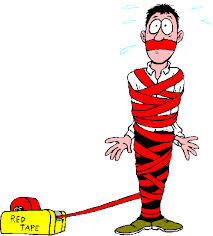One of the things that Nicole and I hear a lot is that people don’t like processes that are just put in place for process’ sake.

Well neither do we.
There is nothing less motivating than having to document in gory detail every step of a business process, just because someone says it’s a good idea. Ok, maybe one thing is less motivating, and that’s having someone hand you a process map and tell you to “follow this” when you’ve had no engagement in its development. You feel like you’re handcuffed by more red tape, and you become frustrated.
Process for process’ sake is bureaucratic, restrictive, and demotivating. Click to Tweet.
And, it Gives Good Processes a Bad Name
I admit it, I’m a little sensitive about the barely concealed eye-roll and sympathetic smile that I often see when I tell people what I do for a living.
“A process consultant! Oh! That sounds… interesting.” And then, “isn’t that just a lot of maps and stuff? I have binders of those in my office and use them every day.” <insert good-natured-but-annoying hardy har hars here>
You can’t really blame the organization. With the rise in popularity of process improvement methodologies like Lean, Six Sigma, ISO, and others, there’s also an increased desire to jump on the band wagon, get certified, and advertise the fact that you are now a high-quality organization.
Well the fact of the matter is that process maps do not a high quality process make. You can map bad processes too! And, you can map good ones poorly. And, worst of all, you can map things that don’t need to be mapped.
Three Ways to Give Your Process Credibility
- Give your process a purpose, and let people know what that purpose is. Why are you insisting that people follow a specific process? Make sure there’s a good reason (e.g. audits, financial controls, quality impacts, budgetary impacts, efficiency impacts), otherwise it’s best to let people have control over how they achieve their objectives.
 Engage people in the development of the process. We love it when we meet with managers who tell us how a process works, and then talk to the people who actually do the work. Usually managers have no idea what really happens. A great way to increase employee engagement is to ask the process users to be part of the documentation and improvement effort. It will make them feel part of the organization, and even address some of the “what’s in it for me” feeling that is deep inside everyone’s work persona.
Engage people in the development of the process. We love it when we meet with managers who tell us how a process works, and then talk to the people who actually do the work. Usually managers have no idea what really happens. A great way to increase employee engagement is to ask the process users to be part of the documentation and improvement effort. It will make them feel part of the organization, and even address some of the “what’s in it for me” feeling that is deep inside everyone’s work persona.- Hold people accountable. Launching a process, engaging people, communicating – that’s all very nice. And in six months no one will remember anything about it, unless you hold people accountable for sticking to the steps. Make it part of your coaching conversations. Model the behaviour you want to see by following processes yourself. Reward people who both stick to them, and consistently strive to make them better.
You don’t have to do process for process’ sake. In fact, we hope you don’t. Help give good processes the recognition they deserve! (And positively transform your organization at the same time.)
Until next time (and Happy New Year, by the way),
Ruth.
